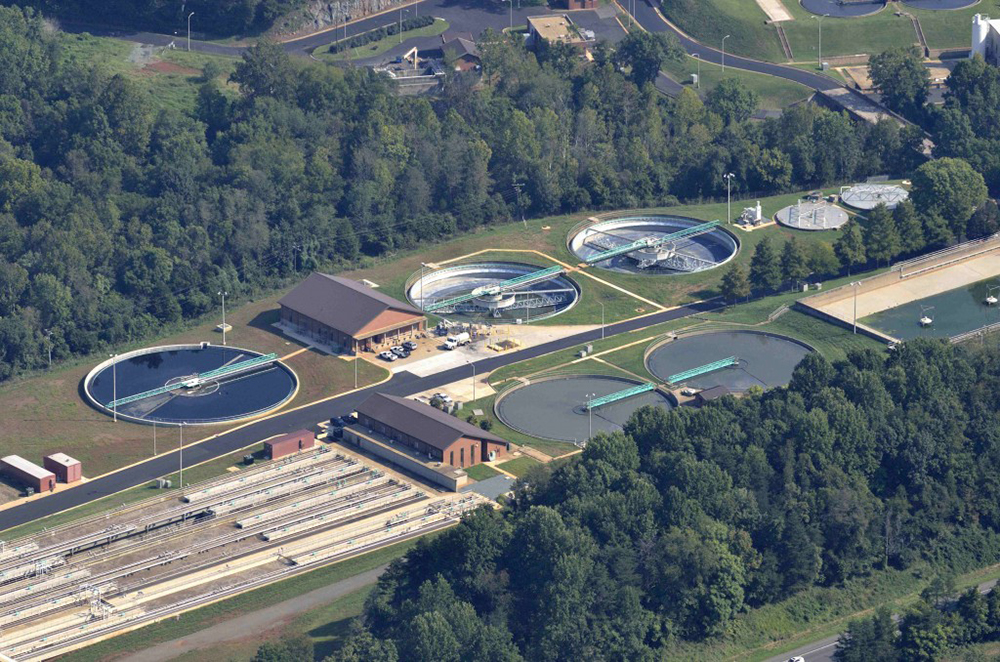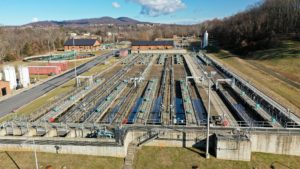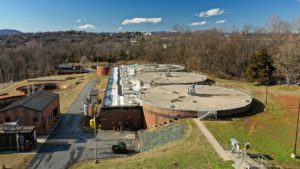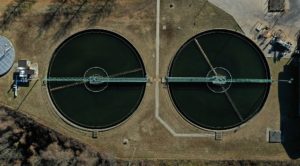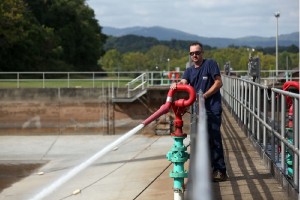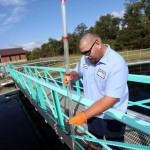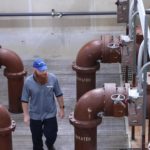-
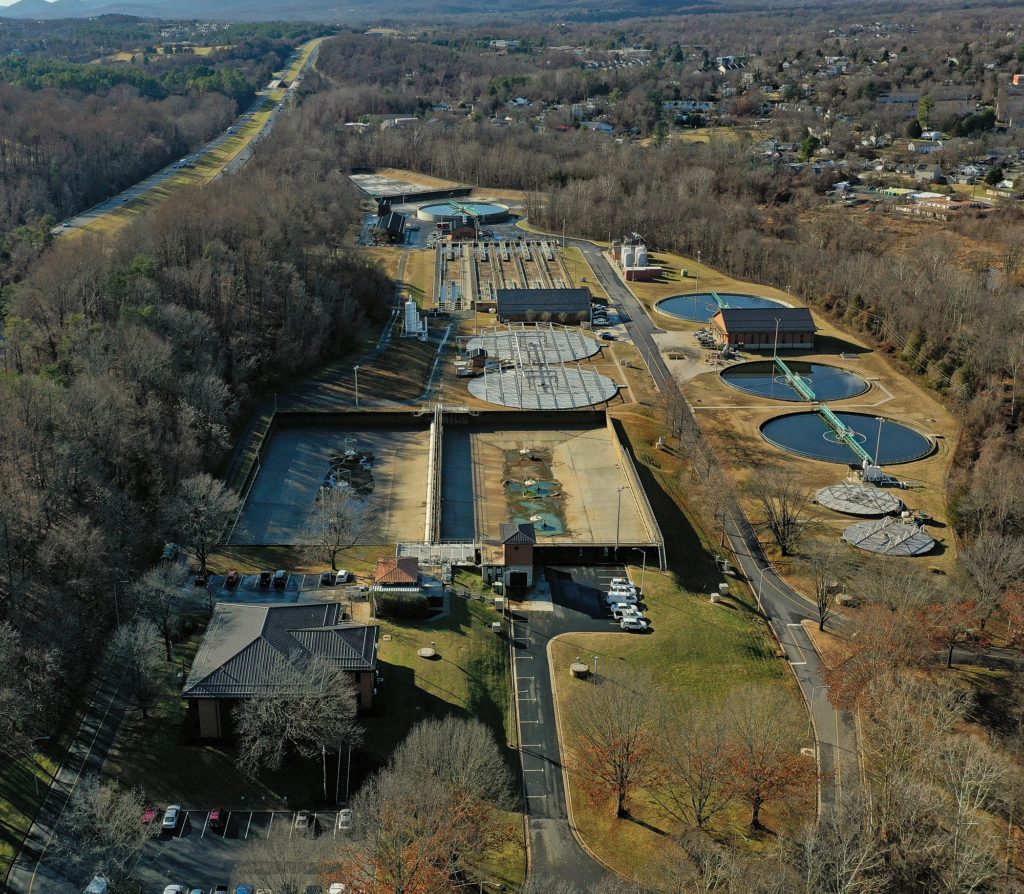
Moore Creek facility for Rivanna Water Sewer Authority, January 2020. Photo/Andrew Shurtleff Photography, LLC
In 2014, RWSA’s Board of Directors renamed all wastewater plants as water resource recovery facilities in recognition of RWSA’s purpose to recover valuable resources from the water treatment process. Resources include high quality water for our local streams to enhance aquatic life, nutrient-rich soil through compost to promote new plant life, and renewable electricity from the combustion of digester gas produced from the anaerobic digestion of biosolids.
Rivanna operates four water resource recovery facilities with a combined capacity of 15.6 million gallons per day (MGD). We handle all wastewater flows from City of Charlottesville and the Albemarle County Service Authority’s municipal collection systems through RWSA’s interceptor system of pipes and pump stations to our recovery facilities. We do this efficiently, economically, and with the environment in mind.
Moores Creek (shown above) is the largest of our Advanced Water Resource Recovery Facilities, which handles all of the urban area and Crozet wastewater. Highly skilled, trained, and licensed staff operate and maintain the treatment processes and regulatory compliance with our federal/state discharge permits.
Supporting Our Community’s Needs
RWSA is recognized as a leader in environmental stewardship, with an impressive record of facility discharge permit compliance. RWSA must comply with Virginia Pollutant Discharge Elimination System (VPDES) permit limitations. The Virginia Department of Environmental Quality issues the discharge permit, which is reviewed and reissued every five years.
Our strong reputation is for not only meeting, but exceeding, requirements in our discharge permits. We have invested in the necessary improvements to meet safety regulations, ensure responsive, reliable service to our customers, and protect our local streams and rivers along with the Rivanna River, James River, and the Chesapeake Bay. We are a charter member of the Virginia Nutrient Credit Exchange Association, earning credits that we sell on the exchange, by removing nitrogen and phosphorus from wastewater above and beyond state permit requirements.
Current Challenge
History, topography, and proximity to Moores Creek have combined to bring us the challenge of operating a large scale wastewater plant in close proximity to neighborhoods and hospitals. In our effort to be good neighbors, we have completed an extensive $10 million dollar odor control project to address this issue. We are installing state-of-the-art facilities including an odor control unit with technologically advanced biological “scrubbers” which “vacuum” the air space, treating and neutralizing the odor compounds. With these new facilities, we expect to eliminate the most egregious odors, keeping them within the facility boundaries. For more about the project go to our Odor Control Project page.
The Wastewater Treatment Process
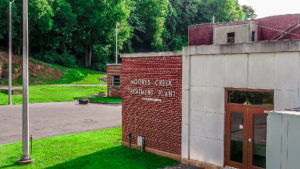
Moores Creek
Treating wastewater protects human and environmental health. Without adequate wastewater treatment, there would be the potential for waterborne diseases such as cholera, dysentery, and typhoid, and we would not be able to use our local waterways as recreational avenues. Wastewater treatment is highly complex, involving physical, chemical, and biological processes.
When wastewater arrives at our water resource recovery facilities, it is referred to as influent. After it is treated and returned to our local waterways, it is referred to as effluent. Oftentimes, effluent can be cleaner than the waterways into which it is released.
Our Water Resource Recovery Facilities
Moores Creek Advanced Water Resource Recovery Facility
Glenmore Water Resource Recovery Facility
Scottsville Water Resource Recovery Facility
Stone Robinson Water Resource Recovery Facility
Rivanna Water & Sewer Authority (RWSA) operates four water resource recovery facilities with a combined capacity of 15.7 million gallons per day (MGD). Wastewater flows from City of Charlottesville and or Albemarle County Service Authority’s municipal collection systems to RWSA’s interceptor system of pipes and pump stations to our recovery facilities. Highly skilled, trained and licensed staff operates and maintain the treatment processes and regulatory compliance with our Federal/State discharge permits.
Steps to Wastewater Treatment
Preliminary Treatment: Removes grit (sand), inorganic debris, and man-made objects.
Primary Treatment: Allows for the settling and flotation of organic and inorganic solids. Heavy solid particles such as food waste sink to the bottom, and lighter organics such as oil and grease float to the top. About 35% of the organics and 50% of the solids are removed.
Secondary Treatment: Uses naturally occurring microorganisms to remove additional organics and solids such as sugars, starches, proteins, detergents, and soaps.
Nutrient Removal: Eliminates most of the phosphorus and nitrogen in the influent wastewater in order to protect the receiving streams, rivers and the Chesapeake Bay from objectionable algal growth.
Disinfection: Kills disease-causing organisms. Effluent is illuminated with ultraviolet light for disinfection, except for the small Stone Robinson facility where chlorine disinfection is used. Chlorinated effluent is dechlorinated before it is released to local waterways; making is safe for aquatic life.
- Aeration Basins
- Digester Building
- Secondary Clarifier
Our Wastewater Operators
Few people realize the pipes, pumps, equipment, processes, and people it takes working 24/7 to treat and clean the wastewater so that it can safely be returned to the aquatic environment. For our community, that means returning the treated water to Moores Creek, which becomes the Rivanna River, which becomes the James, which eventually becomes the Chesapeake Bay.
A typical day for one of our licensed wastewater operators consists of monitoring the local weather conditions and forecast, and monitoring various instruments and equipment to assure operation within proper parameters. Team members perform a number of analyses and evaluations to assure that our technology is functioning properly and our microbiological treatment system is effectively removing pollutants necessary to protect our environment. Team members visually inspect equipment and processes to assure proper operation. Significant wet weather events provide additional challenges as storm water enters the sanitary sewer collection system creating some extreme process flow fluctuations. The operating team must make sure that these fluctuations do not negatively impact the environmental balance in our biological treatment processes.
- Measuring wastewater levels using the “Sludge Judge” (Photo by Andrew Shurtleff)
- Monitoring the Wastewater Treatment Process using the SCADA System
- Inspecting the Pipe Gallery


